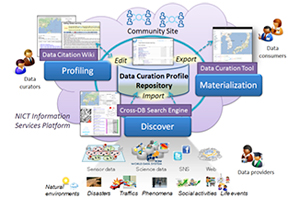Laboratory Overview
The information broadcast on the Internet has become more and more diverse with IoT technology. Many and varied sensors are connected to the Internet, sending out data mechanically, while image and video data captured and edited by people on smartphones and other devices are also being transmitted in massive volumes. As the mainstream shifts away from predominantly text-based digital content that can be searched using conventional Web browsers towards digital content that can be used with various applications on smartphones, the need has arisen for technologies that process not only text-based information, but different types of data from different fields such as sensor-derived information and image and video data, in real time based on users’ requests.
The Information Services Platform Laboratory is engaged in the research and development of leading-edge basic technologies for the utilization of IoT data and image and video data. It has two separate projects: the IoT Data Integrated Analysis Platform Project and the Image Processing Project.
Research Structure

IoT Data Integrated Analysis Platform Project
For details of this project, visit the website of the Big Data Analytics Laboratory in the Big Data Integration Research Center.

Image Processing Project
Outline
The Image Processing Project has been established as a new research domain for NICT, namely, “real-space semantic analysis technology through image and video data.” With the practical aspects of this kind of technology in mind, it will engage in basic research, including some of the most watched, leading-edge analysis technology today.
Aims
Capturing, saving and sharing images has been made exponentially easier with the spread of smartphones, but those images are almost exclusively for personal use, and their use for wider purposes has only just begun. NICT aims to use next-generation image analysis technology to extract higher-order information of image-based big data, and create new added value.
The project will also aim for the reciprocal use of language and speech information, through proprietary NICT technologies such as technology for the analysis of social knowledge and multilingual speech dialogue technology.